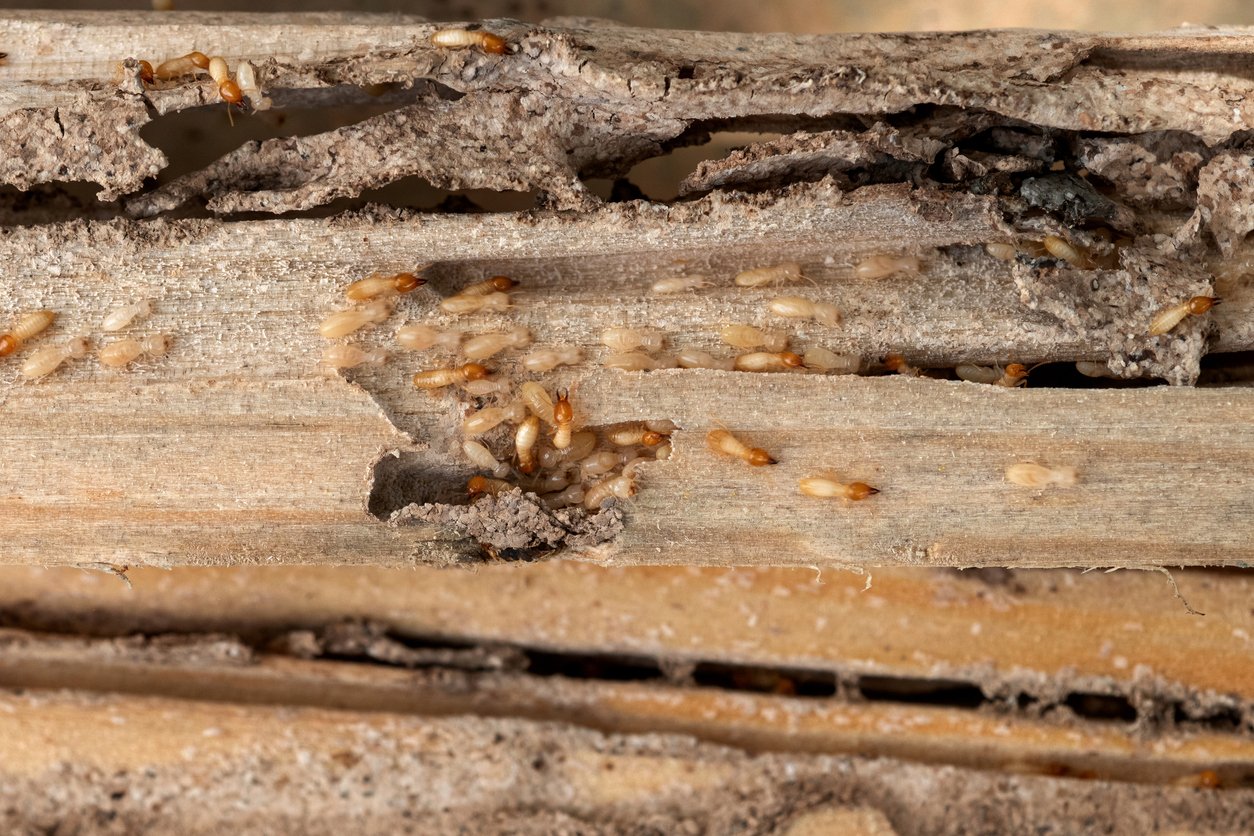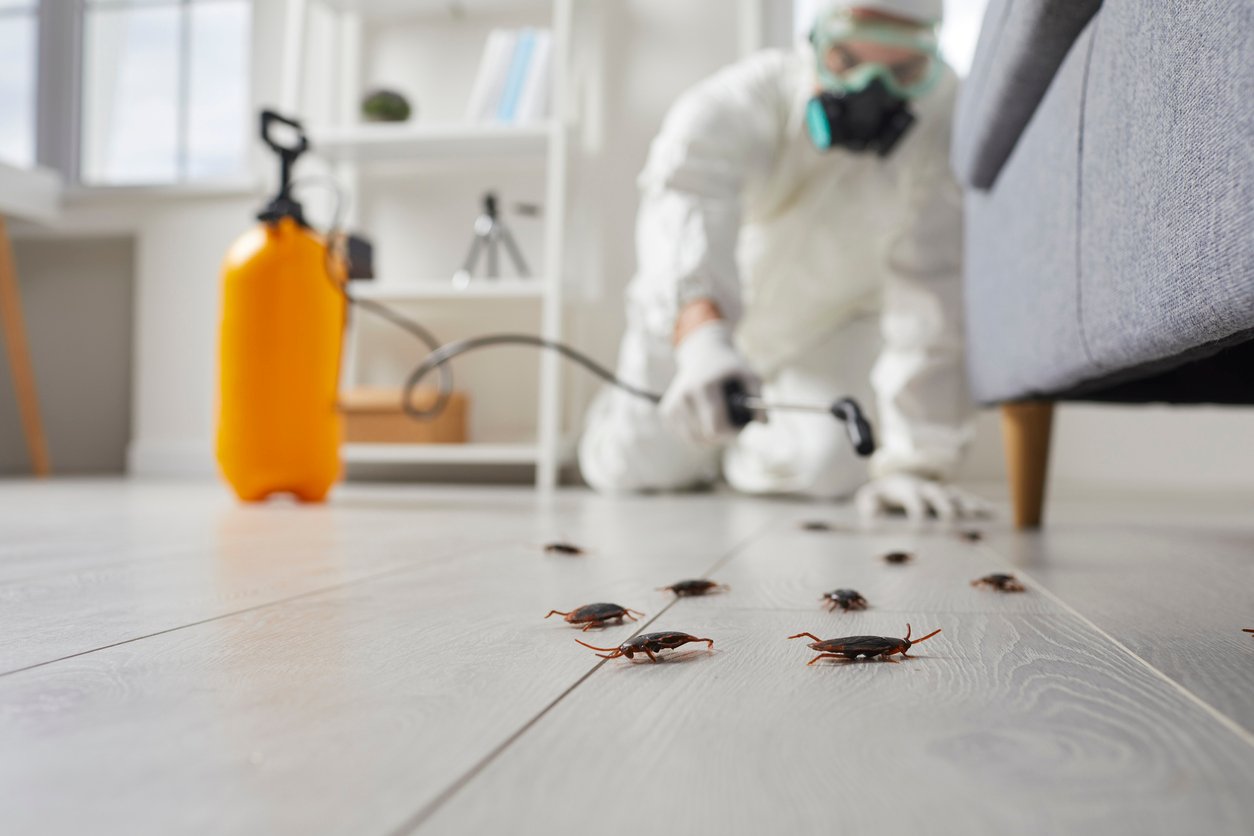Top 5 Most Destructive Pests and How to Prevent Them

It doesn’t take much for pests to cause lasting problems inside a home. Termites can eat through wood from the inside, weakening beams and floors. Rodents gnaw wiring and insulation, potentially creating fire hazards and the need for costly repairs. Silverfish and beetles can destroy books, clothing, and stored goods. Many of these problems develop quietly, and the damage often isn’t obvious until it has already become serious.
Pests can be destructive in many ways. Beyond the stress, embarrassment, and daily disruption they cause, infestations often leave homeowners facing repair bills for structural damage or the loss of belongings that can’t be salvaged.
Here are five of the most destructive household pests and the steps you can take to help prevent them.
1. Termites
Often called “silent destroyers,” termites are among the most costly and damaging pests homeowners face. Because they feed on wood from the inside out, they can go unnoticed for months or even years, all while weakening the very structure of a home.
Why termites cause serious damage
Termites feed on cellulose, the main component of wood and many building materials. Unlike carpenter ants, which hollow out spaces to nest, termites actually consume the wood, weakening its structure over time. They work from the inside out, which means beams, flooring, or trim can appear solid on the surface even as they’re being hollowed beneath. By the time visible signs appear, repairs may already be extensive and expensive.
What to watch for
Because termites stay hidden, early detection depends on knowing the clues. Look for mud tubes climbing up foundation walls or posts, which termites use as protected passageways. Paint that blisters or looks bubbled may be covering damaged wood underneath. Tap on baseboards or flooring that sound hollow, which can indicate tunneling. Tiny, shed wings near windowsills or doors are another warning sign, left behind after swarms of reproductive termites.
How to prevent termites
Moisture control is the first line of defense against termites. Termites thrive in damp conditions, and wood that stays wet is much more likely to become infested. You can significantly reduce risk by keeping structures dry and separating wood from soil contact.
- Fix leaks and drainage issues. Repair dripping pipes or fixtures quickly, clean gutters so water flows properly, and direct downspouts away from the foundation. These steps prevent constant dampness around the base of the home.
- Create separation. Pull mulch and soil back from siding so wood isn’t in direct contact with the ground. Use concrete or metal supports for stairs, fence posts, and firewood racks to keep wood raised and less accessible.
- Store firewood properly. Keep firewood stacks off the ground and away from the home to avoid creating easy bridges that termites can use to reach the structure.
- Schedule professional inspections. Licensed experts at Moxie Pest Control are trained to recognize early warning signs that are easy to overlook. Our Field Experts can install bait systems or apply soil treatments around the foundation, to help protect against infestations and stop colonies before they spread.
2. Rodents (Mice and Rats)
Small but persistent, mice and rats are some of the most common household pests—and also some of the most destructive. They can slip indoors through tiny openings in search of food, water, and shelter, and they can cause significant problems by chewing, nesting, and contaminating the spaces.
Why rodents cause serious damage
Rodents create multiple problems inside a home. Their constant gnawing can wear down wiring, insulation, and even wooden framing. This not only weakens structural components but also increases the risk of electrical fires. Contamination is another major concern—rodent droppings, urine, and nesting materials spread bacteria across food and surfaces.
Rodents also reproduce quickly, turning a few unwanted visitors into a larger infestation in a short period of time.
What to watch for
Rodents rarely stay out in the open, so recognizing their presence depends on noticing indirect signs:
- Small, pellet-shaped droppings inside cupboards, drawers, or along baseboards
- Gnaw marks on food packaging, wires, or wood
- Scratching or scurrying sounds inside walls, ceilings, or attics, especially at night
- Greasy rub marks along baseboards or around openings where they travel repeatedly
- Nests made from shredded paper, fabric, or insulation tucked into hidden corners
How to prevent rodents
The most effective strategy is exclusion—blocking entry points so rodents can’t nest or find food indoors. Combine that with careful sanitation and monitoring.
- Seal openings thoroughly. Rodents can squeeze through gaps as small as a quarter inch. Use exterior caulk to fill cracks, pack spaces around pipes and vents with steel wool, and cover larger gaps with hardware cloth. Door sweeps help block the spaces rodents often exploit along thresholds.
- Control food and water. Store pantry goods and pet food in airtight containers. Clean up crumbs and spills promptly, and avoid leaving dirty dishes out overnight. Fix leaky faucets or pipes and empty standing water, so rodents don’t have easy access.
- Remove shelter. Clear away stacked firewood, bags of soil, or unused containers around sheds and exterior walls. These provide cover and nesting spots close to the house.
- Place traps early and check often. Snap traps set along walls and in areas with droppings can control activity before populations expand. Regular checks prevent unnoticed infestations.
- Call for professional help if signs persist. Ongoing droppings, new gnaw marks, or constant noises often point to an established infestation that DIY methods can’t fully resolve. Moxie Pest Control provides thorough inspections to identify entry points and nesting sites, then Field Experts apply targeted treatments that stop rodents at the source.
3. Bed Bugs
Unlike many other pests, bed bugs don’t damage wood or wiring—but the problems they create can be just as costly and stressful. These tiny hitchhikers spread quickly once indoors, hiding in mattresses, furniture, and cracks where they’re hard to detect. Left unchecked, a small introduction can turn into a widespread infestation that disrupts daily life and sleep.
Why bed bugs cause serious damage
Bed bug infestations become costly because these tiny insects spread quickly and are difficult to remove once they take hold. A few bugs brought in on luggage, clothing, or secondhand furniture can turn into hundreds within a matter of weeks, as each female lays dozens of eggs over her lifetime.
Bed bugs hide in places that are difficult to treat, such as deep inside mattresses, box springs, couches, and small crevices in bed frames or baseboards. When populations grow, these items often become so heavily infested that replacing them is the only option.
Professional treatments are typically required for bed bugs, and the need for multiple visits can add to the expense. On top of the financial strain, bed bug bites cause itching and irritation, and the stress of dealing with an active infestation often leads to anxiety and loss of sleep.
What to watch for
Bed bugs are small and skilled at staying hidden, so infestations are usually recognized by their evidence rather than constant sightings:
- Bites that appear in clusters or lines, often on arms, legs, or exposed skin
- Small, dark fecal spots on sheets, mattress seams, or upholstered furniture
- Shed skins or eggs in mattress tufts, bed frames, or nearby cracks
- Live insects tucked into seams, screw holes, or headboards
How to prevent bed bugs
Bed bugs don’t enter homes in search of food or moisture the way many other pests do. Instead, they’re usually carried inside on luggage, clothing, or used furniture. Because even a few bed bugs can multiply quickly and spread from room to room, it’s critical to detect bed bugs early and act quickly. High heat and properly applied pest control products are effective tools when used the right way.
Reduce the risk of bed bug infestations by focusing on key habits:
- Check secondhand items carefully. Inspect seams, crevices, and screw holes on used beds, sofas, and dressers before bringing them indoors. Even a small number of bugs can seed an infestation.
- Travel cautiously. In hotels or guest accommodations, place bags on hard surfaces rather than upholstered furniture. Keep luggage zipped and elevated to reduce the chance of bringing bed bugs back.
- Wash and heat-dry bedding and clothing. High heat is lethal to bed bugs at all life stages. Running sheets, blankets, and clothes through a hot dryer cycle kills eggs, nymphs, and adults.
- Vacuum thoroughly and often. Focus on mattress edges, box springs, bed frames, and baseboards. Dispose of vacuum bags or empty canisters immediately after use to avoid spreading bugs.
- Seek professional treatment. Bed bugs rarely disappear without intervention. Professional options include heat treatments that raise room temperatures high enough to kill eggs, nymphs, and adults, as well as carefully applied products and follow-up visits to make sure the infestation is fully eliminated.
4. Silverfish
Silverfish are small, fast-moving insects that often go unnoticed until they’ve already damaged belongings. Attracted to dark, humid spaces, they feed on paper, fabric, and starchy materials—putting books, clothing, and stored keepsakes at risk over time.
Why silverfish cause serious damage
Silverfish may be small and quiet, but they can cause extensive damage over time. They feed on starches and proteins, which means they target materials like paper, books, wallpaper paste, photographs, fabrics, and even pantry goods such as flour and cereal. Because they thrive in dark, damp spaces, infestations often spread unnoticed in basements, attics, bathrooms, and closets. The result can be ruined keepsakes, damaged clothing, and contamination of stored food.
What to watch for
Silverfish activity is often subtle but leaves telltale signs:
- Irregular holes or etching on paper, cardboard, and fabrics
- Pepper-like droppings or yellowish stains on stored items
- Live insects scurrying in bathrooms, basements, attics, or closets when lights are turned on
How to prevent silverfish
Silverfish prevention focuses on controlling humidity and reducing hiding spots. Silverfish need high moisture levels to survive, so lowering humidity makes areas less suitable for them to live and reproduce.
- Dehumidify basements and attics. Use dehumidifiers to keep relative humidity below 50 percent. Improve airflow with fans or vents in spaces that stay damp.
- Fix moisture sources. Repair plumbing leaks, seal gaps around tubs and toilets, and insulate cold-water pipes to prevent condensation that creates damp environments.
- Seal cracks and gaps. Close off baseboards, door casings, and utility penetrations where silverfish hide and travel.
- Store valuables properly. Protect books, photos, and textiles by keeping them in sealed plastic bins with desiccant packs to absorb excess moisture.
- Seek professional help for recurring infestations. Because silverfish hide in wall voids and other hard-to-reach areas, store-bought remedies often fall short of eliminating them. Moxie’s professional pest control services provide targeted treatments and ongoing monitoring to target silverfish populations and help keep them from returning.
5. Powderpost Beetles
Powderpost beetles are one of the most destructive wood-boring pests, second only to termites in the damage they can cause. Their larvae tunnel deep into hardwoods, weakening furniture, flooring, and even structural beams from the inside out—often long before homeowners realize there’s a problem.
Why powderpost beetles cause serious damage
Powderpost beetles are second only to termites when it comes to wood-destroying pests. The real damage comes from their larvae, which tunnel deep into hardwoods such as oak, ash, hickory, and walnut. As they feed, they weaken flooring, trim, furniture, and even structural beams from the inside out. Larval development inside the wood can take years, allowing infestations to continue unnoticed until surfaces turn brittle and become riddled with tiny holes.
In severe cases, powderpost beetles can ruin valuable furniture or compromise the integrity of a home’s framing.
What to watch for
Signs of powderpost beetles are often subtle:
- Pin-sized, round exit holes on the surface of wood
- Fine, talc-like powder (frass) beneath or inside infested items
- Surfaces that feel fragile or crumble under light pressure
- Ongoing activity in the same wood over successive seasons, which is a sign larvae are still present
How to prevent powderpost beetles
Prevention focuses on choosing the right wood products and keeping them dry. Powderpost beetles thrive in unfinished or untreated hardwoods with higher moisture levels, so using treated or sealed materials makes infestations far less likely.
- Inspect wood before purchase or installation. Avoid bringing in lumber, flooring, or furniture that shows tiny holes or fine powder.
- Keep wood dry. Ventilate attics and crawlspaces, and address roof or plumbing leaks promptly. Wood with lower moisture content is far less suitable for beetle development.
- Use borate preservatives. Applying borate-based treatments to vulnerable wood penetrates the surface and disrupts larval growth inside.
- Seek professional intervention for active infestations. Store-bought sprays rarely penetrate deeply enough to reach hidden larvae. Moxie Pest Control offers advanced treatments that can eliminate beetles in galleries deep within the wood, followed by monitoring to prevent reinfestation.
Moxie Pest Control: Solutions for Pests That Cause the Most Damage
When termites hollow out wood, rodents chew wiring, or beetles damage furniture, the cost of the damage can add up quickly. Moxie Pest Control provides detailed inspections to catch activity early, precise treatments to target pests directly, and follow-up service to help keep them from returning.
Are you dealing with a destructive pest that wasn’t mentioned in this guide? Check out our pest control information hub for step-by-step prevention tips and advice from the experts.
Not sure if we serve your area? Find all of our pest control locations.
Why homeowners choose Moxie:
- Thorough inspections inside and out to find what is driving the activity
- Field Experts trained daily to apply treatments carefully and precisely, targeting pests where they live and breed
- Family- and pet-friendly approaches applied in accordance with leading best practices
- Unlimited warranty services between visits for year-round plan customers, so you can ask for help anytime
- Instant online quotes to get started quickly
- Quick, easy scheduling that fits your day
- Neighborly service—we’re passionate about helping you feel at home in your home
When destructive pests put your investment and comfort at risk, turn to Moxie for year-round solutions.



